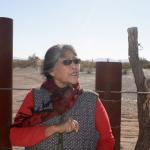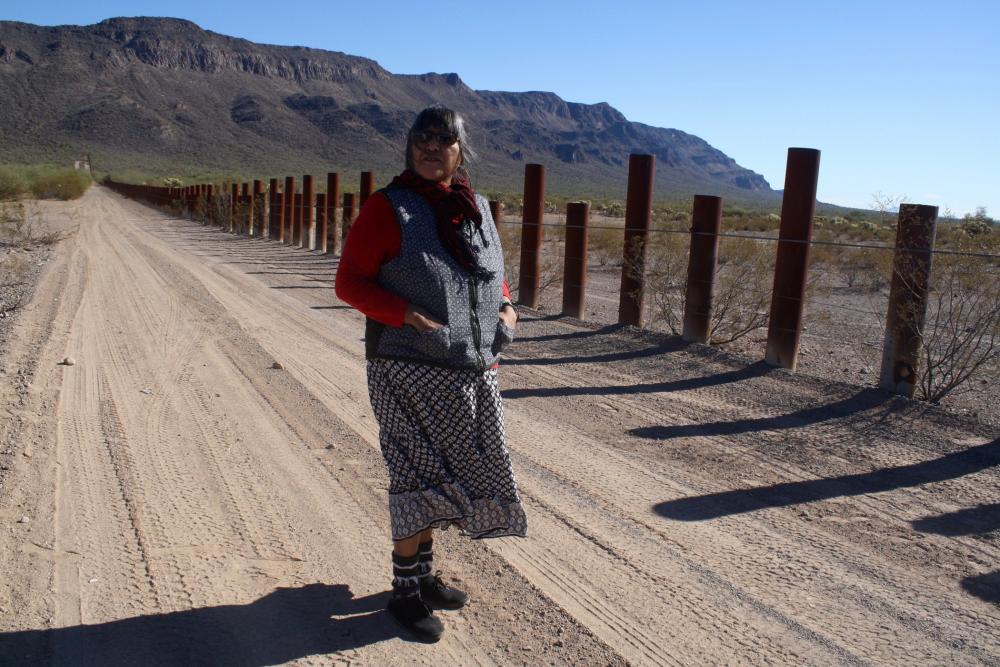A Standing Rock on the Border?

Tohono O’odham activist Ofelia Rivas has a reputation for clashing with U.S. Border Patrol. On her tribe’s 4,500-square-mile reservation, which straddles the U.S.-Mexico border, that can be a stressful vocation. But she doesn’t show it, sharing conversational snippets and a slight, quick grin. Her skin is the color of stained clay, and she cuts a stylish figure: narrow glasses and a red-flecked scarf trailing in the slight breeze. Her black sneakers are gray with dust.
We meet on a flatland in the far-southwestern corner of the Tohono O’odham Nation, a windblown place marked by metal posts marching off to the mountains. The posts are vehicle barriers, set in concrete with a steel cable between them. If President Donald Trump has his way, these posts will be replaced by a massive border wall. But that won’t happen without a fight, and Rivas, organizer of the O’odham Solidarity Project, is helping lead it.
It’s part of a battle that she has been fighting for years. In 2005, National Guardsman ripped open a burial site when they arrived with backhoes and cement trucks to install the vehicle barriers. Rivas gathered a small group of villagers to protest, blocking the only paved road through her village with their bodies and with a car. The military convoy simply rumbled around them, dragging its heavy equipment through the desert. Upon reaching the border, the Guardsmen commenced planting steel posts.
The construction unearthed human remains, some dating back to the 12th century. The skeletons, which included at least two children, were shipped off to Northern Arizona University for lab analysis. It took months for the lab results to come back. “We were told they couldn’t be the remains of our people, because they were too old,” she said, with a sarcastic laugh. “How could they be too old? We’ve been here forever.”
The Tohono O’odham tribe has repeatedly cited the wall’s potential impacts upon sacred sites, burial grounds, and the natural environment. But the roots of tribal opposition date back to the 1854 Gadsden Purchase, when the United States took 30,000 square miles from Mexico for a paltry sum, tugged the border north, and split the O’odham homeland down the middle. Today, thousands of enrolled tribal members still live in villages south of the line. A wall would make their isolation complete.
Already, an increasing federal presence here has wreaked havoc. The Tohono O’odham reservation shares sixty-two miles of border with Mexico, and that stretch of territory has become a battleground, bristling with Border Patrol agents, checkpoints, and military-style command posts.
The flats where we stand were once home to a busy open-air market, drawing O’odham from both sides of the line to trade food crops and gossip. In 2006, the U.S. Border Patrol sealed an informal, international gate there, ending the flow of people that sustained the market. It also made what had been quick trips to Mexico, to visit relatives or attend ceremonies, into day-long ordeals.
Many O’odham villages in Mexico are just a few miles south of the hamlet of Ali Jegk, on the Arizona side where Rivas lives. To reach them now, Rivas must drive seventy miles to the U.S. Port of Entry in Lukeville, cross into Mexico, and then drive seventy miles back on the other side of the line.
According to the Office of National Drug Control Policy, nearly two dozen separate federal agencies currently operate on the O’odham Nation, including the FBI, DEA, and ICE. But the most common face belongs to the Border Patrol.
The North American Congress on Latin America has dubbed the Tohono O’odham homeland a “ground zero” for human rights abuses. Everyone on the reservation knows somebody who’s been rousted, harassed, or manhandled by agents. There are steady complaints about Border Patrol agents running vehicles roughshod over O’odham lands, tearing down fences, ripping up roadways, plowing through ancient burial sites. Those who complain, the tribe says, are ignored.
Many tribal members have reluctantly accepted the federal presence as necessary to protect them against illegal immigration and narcotics smuggling. Yet opposition to the wall is nearly universal among tribal members. In fact, resistance to the proposed wall has become something of a rallying point for other Native Americans, who see it as a threat to their sovereignty. Rivas met many of those from other tribes while protesting the oil pipeline near North and South Dakota’s Standing Rock Sioux Reservation in 2016.
“I think something is going to be happening when they start pushing that wall,” she says. “After Standing Rock, a lot of people are willing to come down to the border and support us.”
Indeed, when Trump signed an executive order authorizing the wall’s construction soon after taking office, “our phones rang off the hook,” says Tohono O’odham Vice Chairman Verlon Jose. “We got calls from Europe and New Zealand, and from people who were at Standing Rock, saying, ‘Hey, we’re ready to go.’”

Whether it will come down to a physical standoff remains to be seen. Hopes for avoiding confrontation were buoyed in March, when Interior Secretary Ryan Zinke toured the O’odham-Mexico borderland with tribal leaders. Earlier, Zinke “had indicated that a wall would be built,” says Jose. “But that’s before he came to the Nation. When he was on the Nation, after talking to the chairman and other tribal council members, he was left with a different sense. He said, ‘I understand your feelings for your land.’
“Now, let’s wait and see,” says Jose. “Our words will not change. We do not support a wall.”
Tim Vanderpool is freelance writer based in Tucson, Arizona.
If you like what you see here, please subscribe to The Progressive digital edition for just $10. Digital subscriptions give you access to all our content with enhanced links and illustrations. Digital subscriptions also support our online reporting and important projects like Public School Shakedown and The Progressive Media Project.
